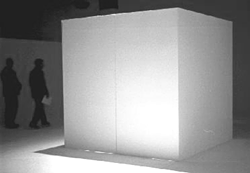

In a bold installation that calls attention to the horrid conditions that await prisoners at the Ohio State Penitentiary, senior Conor Durand set up a mock prison cell inside Fischer Hall.
The installation is made up of an enclosed eight foot by eight foot cell and a video monitor that continually monitors the mock prisoner. Both the cell and the monitor are painted bright white, while a single white light projects on the top of the enclosure. As visitors stroll through the installation there are many different reactions.

Durand said, "People get very tense when they enter the space and they don't know how to act...Some have come to visit their friends and are loud and giggly. Some can't talk at all. It all depends on how deeply the audience wants to be affected."
Durand and Elizabeth Kautz, OC '98, worked together on the installation. Durand was responsible for the artistic side of production and Kautz worked on the activism side. Durand said that while he made the majority of the artistic decisions, Kautz was primarily involved in soliciting the prisoners' testimonies that line the walls. These testimonies are the written descriptions of the atrocities committed in prisons. Durand said, "We were trying to get all different aspects of [prison] life. All the testimonies were written within the last year and a half." Durand noted that some of the letters reflected concern over the suicide of a few prisoners within the walls. He said that the installation is a "push to try to get more rights within the prisons."
The installation opened on Nov. 13 and runs to Nov. 23. Each prisoner stays in the white wooden box for 23 hours. During the 24th hour, Durand comes into the cell and cleans it, getting it ready for the next prisoner. The opening of the exhibition was loosely timed to coincide with last weekend's Ohio Prisoner's Activists Conference. Durand said, "We're trying to expose the isolation in the Ohio State Penitentiary and we did try to time it to open with the conference. We're trying to get the reactions of different prisoner activists in town for the conference."
The installation is more than just a physical space; it inspires artists and activists alike to think of the mind-numbing characteristics of prisons. Durand said, "The piece goes beyond prison aspect and they start thinking about isolation. It's kind of an intensity that's hard to deal with. That kind of isolation has been clinically proven to destroy people's minds."
In order to watch monitor of the prisoner, the visitor must walk down a long, white corridor that calls to mind the corridor leading to a gas chamber or electric chair. Watching the prisoner on the monitor is a voyeuristic experience; the prisoner, in forced isolation, cannot escape the visitor's inscrutable eye.
To get the true experience, one must visit the sparse installation when no one else is in the room. Having the freedom to move across the creaking floor while another human is trapped inside a cage, albeit temporary and wooden, is a feeling that does not easily leave the visitor's mind. The strength of the installation lies in the power of the visitor's mind to visualize himself trapped in the closed space. Watching the constant video surveillance feels like an invasion on the prisoner's personal space, especially if he/she is sleeping. The sleeping prisoner is powerless to the visitor's peering eyes. In this case, the visitor is given the same power as the warden - he can spy on the prisoner while the prisoner must sit in silent isolation.
Durand considers the installation valuable practice for future endeavors. He said, "We're looking at this as a stepping stone. We're going to be documenting this piece very well, with the hope of making it into a stronger piece." If Durand and Kautz continue according to their plan, their piece will only gain intensity. Already the installation forces the visitor to imagine their life in captivity; any more contemplation is almost a violation of personal freedom.
Mock lock-up: Senior Conor Durand's installation mimics the isolating experience of living in prison, right down to the mind-numbing effects on the prisoner. The show runs through Nov. 23. (photo by Areca Treon)
Copyright © 1999, The Oberlin Review.
Volume 128, Number 10, November 19, 1999
Contact us with your comments and suggestions.